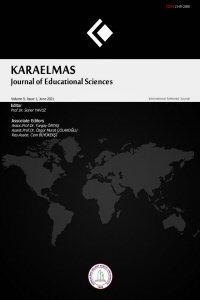Bergson’un Süre Kuramının “Günden Geceye”, “Satıcının Ölümü”ve “Sırça Kümes” Oyunlarındaki Yansımaları
Düşünce tarihi boyunca filozof ve düşünürler, zaman kavramını anlamaya ve açıklamaya çalışmışlardır. Ancak, geleneksel zaman anlayışı yirminci yüzyılın başında Fransız filozof Henri Bergson'un fikirleri yayımlayıncaya dek pek değişmemiş; zaman, kronometrik ve doğrusal olarak görülmüştür. Bergson, zamanı mekanla ölçerek geçmiş, şu an ve gelecek olmak üzere üç farklı bölüme ayıran filozofları eleştirmiş; geçmişin ve şimdiki zamanın birbirini takip eden apayrı iki oluş olmadığını savunmuştur. Bergson'a göre geçmiş ve şimdiki zaman birbiriyle iç içedir. Bergson'un geleneksel zaman anlayışına bu şekilde karşı gelmesi, Avrupa'da modern insanın kronolojik zamana olan güvenini sarsmış ve zamanın yarattığı illüzyonun yıkımına yol açmıştır. Daha sonra Bergson'un zaman üzerine fikirleri Amerika'ya ulaşmış ve oradaki düşünür ve yazarların zaman kavramını sorgulamasını sağlamıştır. Ayrıca bu yeni zaman algısı Amerika'da başka bir aldatmaca olan Amerikan Rüyası'nın da yıkılmasına katkıda bulunmuştur. Gelişim ve ilerleme fikriyle yakından ilişkili olduğundan Amerikan Rüyası ancak ve ancak doğrusal bir zaman dizisinde gerçekleşebilir, Bergson da böyle bir ardışıklığı kabul etmemektedir. Bu nedenle denilebilir ki Bergson'un süre kuramı doğrusal zaman görüşünün eksikliklerini ortaya dökerek bir yandan da Amerikan Rüyası'nın anlamsızlığına işaret etmektedir. Amerikan tiyatrosunun en başarılı örneklerinde Bergson'un süre kuramının izlerine rastlamak mümkündür. Dolayısı ile bu çalışmada Bergson'un süre kuramının Eugene O'Neill'ın Günden Geceye, Arthur Miller'ın Satıcının Ölümü ve Tennessee Williams'ın Sırça Kümes oyunlarındaki yansımalarını Mary Tyrone, Willy Loman ve Wingfield ailesinin üç üyesi olan Amanda, Tom ve Laura karakterleri üzerinden incelemek amaçlanmıştır
Anahtar Kelimeler:
Zaman, Süre Kuramı, Amerikan Tiyatrosu, Amerikan Rüyası
Reflections of Bergson's Duration Theory on “Long Day's Journey into Night”, “Death of a Salesman” and “The Glass Menagerie”
Throughout the history of thought, philosophers and thinkers have tried to understand and explain 'time' in their own ways. Yet, the conventional concept of time -a chronometric, linear construct- had not changed much until the beginning of the twentieth century when the French philosopher Henri Bergson published his revolutionary ideas about 'time'. For Bergson, the previous thinkers' explanations of time were unacceptable since they rated time with space and divided it into three distinct units the past, the present and the future. Challenging this long-established belief, he asserted that the past and the present are not different entities which succeed one another linearly. Instead, the past and the present intermingle with each other, according to Bergson. His attack on the traditional concept of time contributed to loss of trust of people living in the Modern Era in mechanic perception of time and paved the way for breaking the illusion of it in Europe. Later, his radical opinions reached America and enabled the American intellectuals to question their views on time. However, in America, the new time perception introduced by Bergson did more than just providing a new understanding of time. It also helped the breaking of another deception; the American Dream. Since the American Dream is closely related to the idea of progress, it can only be realized in a linear time sequence which was rejected by Bergson. Demonstrating the deficiencies of the linear concept of time, Bergson's ideas also imply the meaninglessness of the American Dream. It is possible to find the marks of Bergson's "duration theory" in the masterpieces of the American drama. Accordingly, in this article, it is aimed to analyse Bergson's "duration theory" in Eugene O'Neill's Long Day's Journey Into Night, Arthur Miller's Death of a Salesman, and Tennessee William's The Glass Menagerie investigating the characters Mary Tyrone, Willy Loman, and the three members of the Wingfield family; Amanda, Tom and Laura
Keywords:
Time, Duration Theory, American Drama, American Dream,
___
- Al-Saji, A. (2007). The temporality of life: Merleau-Ponty, Bergson, and the immemorial past. The Southern Journal of Philosophy,45, 177-206. doi: 10.1111/j.2041-6962.2007.tb00048.x
- Bergson, H. (1950). Time and free will. George Allen & Unwin Ltd. Retrieved from http://intersci.ss.uci.edu/wiki/eBooks/BOOKS/Bergson/Time%20and%20Free%20Will%20Bergson.pdf
- Bergson, H. (2007). The creative mind. Dover Publications: New York. Retrieved from https://books.google.com.tr/books?id=mC0UG66MG98C&hl=tr&source=gbs_book_other_versions
- Gex, S. (2010). Bergsonian memory and time in T.S. Eliot's beginning and end (master's thesis). California State University, Sacramento, The United States of America. Retrieved from https://csusdspace.calstate.edu/bitstream/handle/10211.9/955/Shadi%20Gex%20M.A.pdf?sequenc
- McMahon, S. (2013). Henri Bergson, duree reelle and high modernism (master's thesis). The University of Wales Trinity Saint David, Great Britain. Retrieved from http://repository.uwtsd.ac.uk/376/1/Sarah%20McMahon%20new.pdf
- Messner, S. & Rosenfeld R. (2013). Crime and the american dream. Wadsworth Cengage Learning: Belmont, CA. Retrieved from https://books.google.com.tr/books?id=DaMKAAAAQBAJ&hl=tr&source=gbs_navlinks_s.
- Miller, A. (1961). Death of a salesman. Penguin Books: Great Britain.
- Moore, L. R. (2013). “Ravaged by time”: the effects of the past and future on the present in the glass menagerie. English Seminar Capstone Research Papers. 14, 2-28. Retrieved from http://digitalcommons.cedarville.edu/english_seminar_capstone/14.
- O'Neill, E. (1989). Long day's journey into night. Yale University Press: London. Randall, B. (2007). Modernism, daily time and everyday life. Cambridge University Press: Cambridge. Retrieved from http://libgen.io/book/index.php?md5=62C12AAFF28CAAEBA0FC54845D139F92
- Restrepo, J. A. F. (2015). Durée and temporality: a defense of Bergson’s conception of time. Discusiones Filosóficas, 16(27), 49-61. doi: 10.17151/difil.2015.16.27.4
- Salley, K. (2015). On duration and developing variation: the intersecting ideologies of Henri Bergson and Arnold Schoenberg. A Journal of the Society for Music Theory, 21(4), 1-19. Retrieved from http://www.mtosmt.org/issues/mto.15.21.4/mto.15.21.4.salley.pdf
- Tapınç, M. (2014). Perception and time-experience in Merleau-Ponty and Bergson. Uludağ University Faculty of Arts and Sciences Journal of Philosophy, 23(23), 163-184. Retrieved from http://dergipark.gov.tr/download/articlefile/149797.
- Williams, T. (2011). The glass menagerie. New Directions: New York.
- ISSN: 2148-2888
- Yayın Aralığı: Yılda 2 Sayı
- Başlangıç: 2013
- Yayıncı: Zonguldak Bülent Ecevit Üniversitesi
Sayıdaki Diğer Makaleler
Öğretmen Adaylarının ve Öğretmenlerin Çocuk Edebiyatına İlişkin Görüşleri
Kanada ve Türkiye 5. Sınıf Fen Bilimleri Dersi Öğretim Programlarının Karşılaştırılması
Özgür Murat ÇOLAKOĞLU, Esma Nur KARAMEŞE
Öğretmenlerin Üstün Yetenekli Öğrencilerin Özellikleri ve Eğitimlerine Yönelik Algıları
Çiğdem AKKANAT, Neşe KUTLU ABU, Murat GÖKDERE
Erdal YILDIRIM, Turgay ÖNTAŞ, Şule EGÜZ
Öğrencilerin Öğretmen Davranışı Algısı ile Dil Öğrenme Kaygıları Arasındaki İlişki
Pınar YÜNCÜ KURT, Hüseyin KURT
